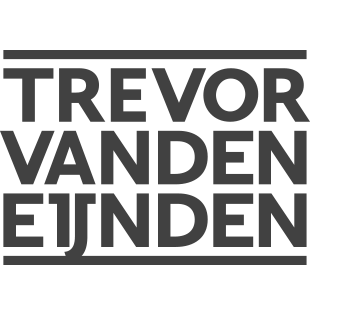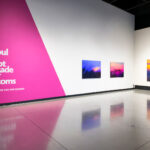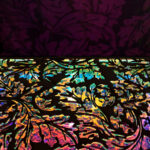a
soul
is
not
made
of
atoms
Trevor Van den Eijnden
Solo Exhibition
2020
The Reach Gallery Museum
Abbotsford, British Columbia
Monogram
The monogram for this exhibition may be downloaded here as a PDF, or viewed in the gallery below.
a soul is not of atoms
Text by Dr. Adrienne Fast; Images by SITE Photography and the artist.
In January 2020, The Reach opened a major solo exhibition of the work of Vancouver-based artist Trevor Van den Eijnden. Titled a soul is not made of atoms, the exhibition presents several distinct bodies of work that are thematically linked through an exploration of grief, the Sublime, and our experiences of time and nature. The artist filters these weighty concepts through his own personal lens, while also considering how these ideas have played out in the past, and how they could manifest in the future.
Van den Eijnden is particularly interested in exploring the ways in which we, as human beings, experience time. He notes that some of the most ground-breaking work being done today in modern physics suggests that time as we understand it ceases to exist at the quantum level, and that although we experience time flowing from the past into the future, in a very real sense all time actually exists all the time. This realization has prompted the artist to explicitly reference both the past and the future in his work, as a kind of reaching both forward and backward in time to achieve what he calls “a remembrance of the future and an anticipation of the past.” This quality of Van den Eijnden’s work is particularly evident in a series of six large-scale photographs from the super saturates series(2007–ongoing). Immediately striking both due to their imposing scale and for their intense, candy-like hues, these photographs yield certain details on closer reading that complicate their immediate and visceral visual appeal.
The super saturates are landscape photographs taken by Van den Eijnden in British Columbia at specific moments when forest fire ash was dramatically altering the colour of the atmosphere and sky. After taking the photos almost instinctively, the artist struggled for a time to decide exactly how he wanted to use them. Inspiration came eventually from a scientific paper published in the journal Atmospheric Chemistry and Physics, in which the authors analyzed hundreds of historical landscape paintings looking for correlations between the colours of painted skies and known volcanic events that occurred between the years 1500 and 1900.1 By measuring the red-to-green ratios (R/G) of sunsets known to have been painted before, during, and following major volcanic eruptions, the authors of the paper were able to estimate 400 years of Aerosol Optical Depth (AOD), a measure of aerosols, particulates, smoke, and other
forms of air pollution.
Van den Eijnden was particularly interested in the data related to paintings by the nineteenth century British Romantic artist J.M.W. Turner, who quite famously painted a number of landscapes of erupting volcanoes, which invariably featured intensely coloured skies. According to the scientific paper, Turner painted skies with 76.7% enhanced RIG values in 1818, 79.2% in 1832, and 97.7% in 1835, in each case corresponding to a known volcanic event. Using this data as a guide, Van den Eijnden returned to his original photos with the intention of intensifying their original colours, using the measurements of Turner’s sunsets as a guide. In some cases, Van den Eijnden has altered his images quite significantly, in other cases only very slightly. But in none of the photos does he introduce any entirely new colours; rather, he ramps up the existing saturation in order to present what the artist calls “hypothetical future landscapes.” In these photographs Van den Eijnden hypothesizes that the vibrancy and colour of our skies is going to change dramatically in the future as a result of climate change. In this way, the super saturates reach back in time-to specific nineteenth century environmental events, and how they became encoded in art history-in order to tell a predictive future. The work suggests that we can look to past environmental disasters to find a glimpse of what our future baselines may become.
The super saturates also introduce another common theme that runs through the artist’s practice: the experience of ecological grief caused by the current Anthropocene era, and the intensity with which contemporary behaviours continue to damage the environment. This concept is explored in two separate but related bodies of work in the exhibition: familiar strangers (2014–ongoing), a series of small, delicate, laser-cut paper sculptures attached to the walls of the gallery, and sham–real shadows (2017), a sculptural and light installation that projects patterned light in all directions, from the centre of a discrete gallery space.
familiar strangers and sham–real shadows are connected by their exploration of the relationship between human beings and the environment-with particular interest in how that relationship has evolved since the beginnings of the Industrial Revolution. Van den Eijnden pursued an intense period of research into the art and design of the nineteenth century, seeking evidence of how the changing relationship between mankind and nature was manifested visually at that time. This broad framework for inquiry eventually narrowed to focus on the history and development of naturalistic wallpaper designs intended to decorate the domestic interiors of homes that were often located in highly industrialized cities. Van den Eijnden was particularly drawn to the work of renowned designer William Morris, who, at the height of the Industrial Revolution was creating highly stylized, intricate patterns inspired by nature, for which he continues to be well known to the present day. Morris was a vocal proponent of the idea that nature and design ought to be intertwined, and that it was impossible to conceive of humanity and nature as independent of each other. By situating these ideas in the context of the Anthropocene, Van den Eijnden reinterprets Morris’ ideas to make them relevant to the contemporary moment.
familiar strangers is a series of laser-cut paper boxes, each featuring a different historical wallpaper design that highlights romanticized, nineteenth century attitudes toward nature, and the concurrent desires to both order and contain it. The edges of the paper are slightly singed by the laser-cutting process, and the resulting burnt edges suggest the destructive processes of resource extraction on the environment at large. While on display in The Reach’s dimly-lit grotto gallery, visitors were encouraged to use a flashlight to interact with the familiar strangers; as a light source moves around each box, the pattern’s shadow becomes both distorted and animated against the dark walls of the gallery space, extending in all directions. Here, human action is absolutely necessary to create a representation of nature, the interaction implicating the viewer in the life and dynamism of these faux-natural scenes.
sham–real shadows is a project that developed out of the familiar strangers, and which takes these ideas a step further. The work consists of an acrylic and wood sculpture set in the centre of a square room. The structure is laser cut in the pattern of William Morris’ acanthus leaf wallpaper pattern – possibly his most famous wallpaper design – from 1874. At the apex of the Industrial Revolution, Morris created highly stylized designs like this one in response to his contemporaries who strove for what he considered to be overly naturalistic patterns. Morris rejected attempts to reproduce the natural world with verisimilitude, calling such patterns” … sham-real [branches] and flowers, casting sham–real shadows.”2 In Van den Eijnden’s work, Morris’ comments become the catalyst for an immersive polychrome experience. By illuminating the laser cut pattern through micro-prism film, the walls of the room are transformed into a wash of pattern and colour, that the artist calls “shadow paper.” Here, again, the viewer is an active participant — the pattern literally falls on our bodies as we view the work. The intertwining of nature and human is complete.
For Van den Eijnden, the transformation from object to shadow is also particularly important. Shadows can be conceived of as a kind of echo of a real object, in the same way that a designed representation of nature is a kind of echo of nature itself. But Van den Eijnden would argue that, in our current world, we do not have access to an unfiltered or unmitigated experience of nature; there isn’t a square inch of the planet that hasn’t been affected by nuclear fallout, for example. Although a shadow or a representation is not the “real thing,” Van den Eijnden’s work suggests that the mitigated experience can matter in its own right – it may be qualitatively different, but it is no less real. He hopes that by bringing together in these works a kind of tension between nature, and human design, and art, there is a new space opened up where we can appreciate the interconnectedness of all three, and where viewers can have a joyful, even a spiritual response, to something that isn’t “true.”
sham–real shadows also function as a pivot point in the exhibition as a whole. The twilight effect of the coloured “shadow paper” on the walls of its self-contained gallery room functions as bridge between the bright daylight space occupied by the super saturates, and the dark, dreamlike space that contains the final bodies of work in the exhibition. In this way, just as the individual works in the exhibition reference our experience of the passage of time, the exhibition as a whole reference the passage of a single day as we move from daylight to darkness. In the final, darkened spaces of the exhibition, visitors encounter several bodies of work that combine the dominant themes of the artist’s practice: an exploration of our relationship with nature — and related experiences of ecological grief — and also our relationship with time, and the forging of connections between past, present, and future.
shored lines (2014-ongoing) is a series of bookwork sculptures displayed on a flat surface. Each book represents the topography of a different landscape, rendered in a kind of stepped elevation. The pages of the book are matte black, and as you “read” the book and turn the pages, move and more of the landscape is submerged beneath these black waves. The geographies represented in these works have been chosen by the artist specifically because they will see dramatic changes as a result of rising ocean levels. These include the land bridge between Nova Scotia and New Brunswick which is very likely to erode away in the future, and a point of land in Russia where it is predicted that the Black Sea will eventually flood into the Caspian Sea. These particular locations serve as catalysts for the imagination, because as human beings it can be difficult for us to discern and respond to small, incremental changes to things like temperatures and ocean levels. But these locations will be the sites of breakthrough moments, when geological time will feel accelerated and the effects of climate change will be more immediately apparent and consequential. Although these works predict a future that could be increasingly dark, they also hold out hope that such breakthrough moments and cataclysmic geographies can provoke a similar seismic shift in human thinking and behavior.
The shored lines book works appear very different from another body of work displayed nearby, titled the relics (2015-ongoing), but they actually have a great deal in common thematically. Part of a larger series, four relics are displayed in the exhibition, each one consisting of a small diorama placed inside an “infinity box” made from five sides of surveillance Plexiglass, with a light source concealed in its plinth underneath. When illuminated, each box creates an outwardly expanding repetition of reflected pattern that seems to extend forever into an indeterminate space. The patterns appear to be projected into infinity — not only into infinite space, but also by implication into infinite time.
Each diorama creates a pattern that the artist sees as embodying a particular anxiety of the present moment. For example, one relic contains a series of menacing black spikes that forms a “landscape of repulsion” based on a mock-up of a conceptual landscape of concrete thorns proposed to be built over the Yucca Mountain radioactive waste disposal site, intended to warn future generations (or future species) away from a site of danger. Another relic contains a piece of uranium infused slag glass, and another contains miniature versions of pink flamingo lawn ornaments; those perfect metaphors for the human tendency to replace actual nature with plastic copies of it. The focus of all of the relics is on non-biodegradable materials that will become part of the future geological record of our Anthropocene era. Certainly, the idea of populating infinite space and time with the anxieties of the present is disturbing, but the relics are also hauntingly beautiful, even vulnerable, in their glittering delicacy.
The qualities of beauty, anxiety, and vulnerability are shared by the final works in the exhibition: a series of wall-mounted, text–based works titled a salve for grief(2020). In these works, the artist forges a connection between the collective experience of ecological grief, and the personal experience of individual grief that each of us encounters in our lives. The texts are taken from a journal written by Van den Eijnden as a way of working through the illness and death of a beloved pet, and they are rendered in a micro-prism acrylic that appears to change colour as visitors move around the works. The ambiguous language in Van den Eijnden’s phrases, coupled with the dynamic spatial and chromatic qualities of these works remind us that grief is never static, rather it is always something lived with and through over time. Texts such as “this death is a depth,” “infinity ends with us,” and “our sad fragments live on” are poignant and moving, and are intended as a reminder of the beauty that persists and can be found even in loss, despair, or the navigation of a new reality.
When a soul is not made of atoms opened at The Reach in January 2020, we could not have predicted the changes we were about to experience in our collective realities a result of the COVID-19 pandemic. The exhibition was closed temporarily in March, then reopened in June and extended to August 2020, making it one of the longest exhibitions in The Reach’s history. Inadvertently, the extension of the exhibition from winter, through spring, and into summer further reinforced and encouraged a careful consideration of how we experience the passage of time. In· a time of accelerated change and ongoing uncertainty, Van den Eijnden’s work encourages us to look again, and in doing so, to consider that moments of joy can be found even in times of difficulty and the navigation of a “new normal.”
1 Zerefos, C. S., Gerogiannis, V. T., Balis, D., Zerefos, S. C., and Kazantzidis, A., “Atmospheric Effects of Volcanic Eruptions as Seen by Famous Artists and Depicted in Their Paintings,” Atmospheric Chemistry and Physics, 110. 7 (2007), 4027-4042. https://acp.copernicus.org/articles/7/4027/2007/acp-7-4027-2007.pdf Following pages: Installation view of the intervals, 2020, reflective vinyl, dimensions variable. lmage courtesy of the artist.
2 William Morris, “Some Hints on Pattern-Designing,” a lecture delivered at The Working Men’s College, London, December 10, 1881. Published by Longman & Co., London, 1899.




